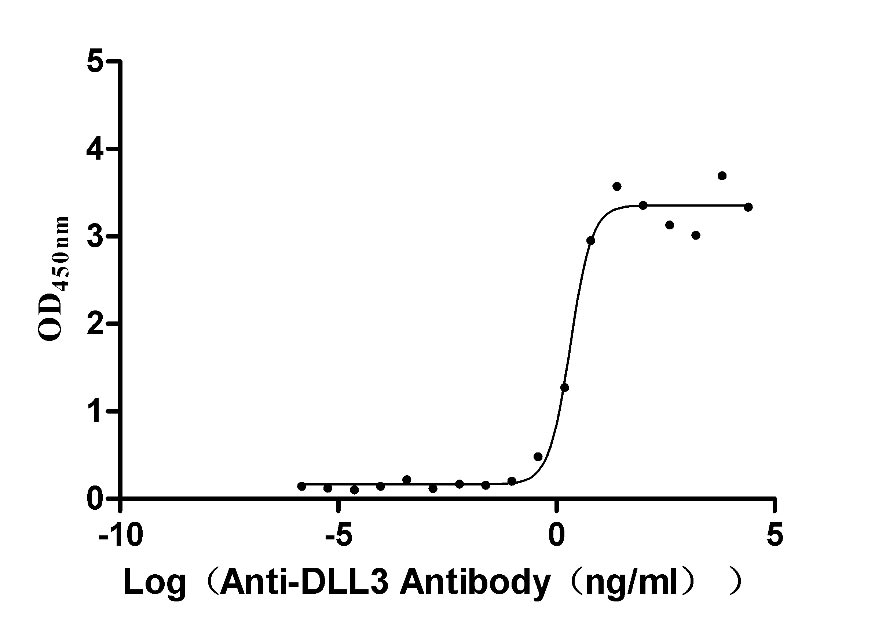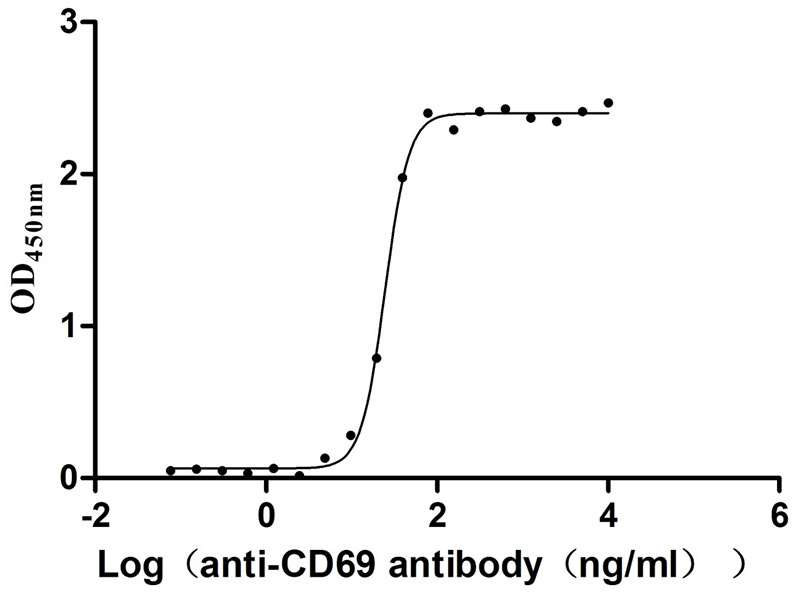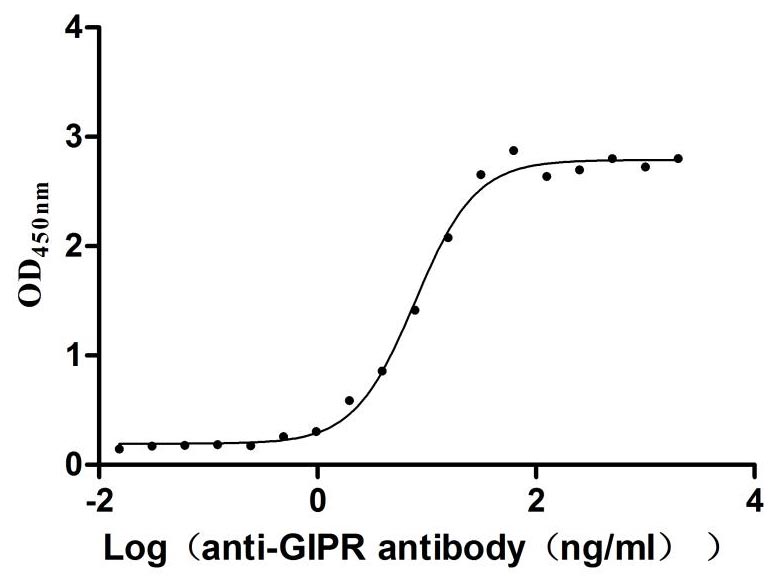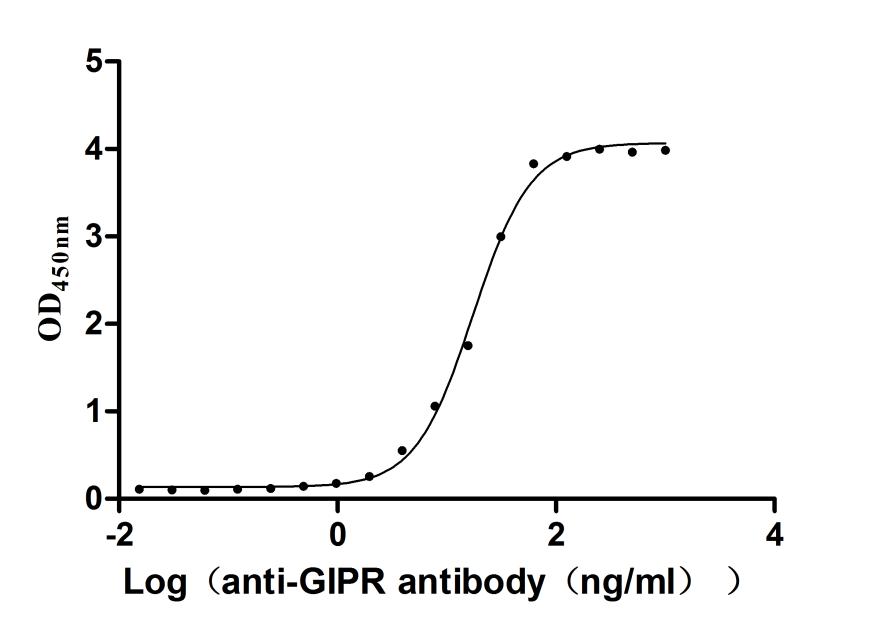Recombinant Saccharomyces cerevisiae NAD-dependent histone deacetylase SIR2 (SIR2), partial
-
中文名稱:釀酒酵母SIR2重組蛋白
-
貨號(hào):CSB-YP361922SVG
-
規(guī)格:
-
來源:Yeast
-
其他:
-
中文名稱:釀酒酵母SIR2重組蛋白
-
貨號(hào):CSB-EP361922SVG
-
規(guī)格:
-
來源:E.coli
-
其他:
-
中文名稱:釀酒酵母SIR2重組蛋白
-
貨號(hào):CSB-EP361922SVG-B
-
規(guī)格:
-
來源:E.coli
-
共軛:Avi-tag Biotinylated
E. coli biotin ligase (BirA) is highly specific in covalently attaching biotin to the 15 amino acid AviTag peptide. This recombinant protein was biotinylated in vivo by AviTag-BirA technology, which method is BriA catalyzes amide linkage between the biotin and the specific lysine of the AviTag.
-
其他:
-
中文名稱:釀酒酵母SIR2重組蛋白
-
貨號(hào):CSB-BP361922SVG
-
規(guī)格:
-
來源:Baculovirus
-
其他:
-
中文名稱:釀酒酵母SIR2重組蛋白
-
貨號(hào):CSB-MP361922SVG
-
規(guī)格:
-
來源:Mammalian cell
-
其他:
產(chǎn)品詳情
-
純度:>85% (SDS-PAGE)
-
基因名:SIR2
-
Uniprot No.:
-
別名:SIR2; MAR1; YDL042C; D2714; NAD-dependent histone deacetylase SIR2; EC 2.3.1.286; Regulatory protein SIR2; Silent information regulator 2
-
種屬:Saccharomyces cerevisiae (strain ATCC 204508 / S288c) (Baker's yeast)
-
蛋白長(zhǎng)度:Partial
-
蛋白標(biāo)簽:Tag?type?will?be?determined?during?the?manufacturing?process.
The tag type will be determined during production process. If you have specified tag type, please tell us and we will develop the specified tag preferentially. -
產(chǎn)品提供形式:Lyophilized powder
Note: We will preferentially ship the format that we have in stock, however, if you have any special requirement for the format, please remark your requirement when placing the order, we will prepare according to your demand. -
復(fù)溶:We recommend that this vial be briefly centrifuged prior to opening to bring the contents to the bottom. Please reconstitute protein in deionized sterile water to a concentration of 0.1-1.0 mg/mL.We recommend to add 5-50% of glycerol (final concentration) and aliquot for long-term storage at -20℃/-80℃. Our default final concentration of glycerol is 50%. Customers could use it as reference.
-
儲(chǔ)存條件:Store at -20°C/-80°C upon receipt, aliquoting is necessary for mutiple use. Avoid repeated freeze-thaw cycles.
-
保質(zhì)期:The shelf life is related to many factors, storage state, buffer ingredients, storage temperature and the stability of the protein itself.
Generally, the shelf life of liquid form is 6 months at -20°C/-80°C. The shelf life of lyophilized form is 12 months at -20°C/-80°C. -
貨期:Delivery time may differ from different purchasing way or location, please kindly consult your local distributors for specific delivery time.Note: All of our proteins are default shipped with normal blue ice packs, if you request to ship with dry ice, please communicate with us in advance and extra fees will be charged.
-
注意事項(xiàng):Repeated freezing and thawing is not recommended. Store working aliquots at 4°C for up to one week.
-
Datasheet :Please contact us to get it.
靶點(diǎn)詳情
-
功能:NAD-dependent deacetylase, which participates in a wide range of cellular events including chromosome silencing, chromosome segregation, DNA recombination and the determination of life span. Involved in transcriptional repression of the silent mating-type loci HML and HMR and telomeric silencing via its association with SIR3 and SIR4. Plays a central role in ribosomal DNA (rDNA) silencing via its association with the RENT complex, preventing hyperrecombination, and repressing transcription from foreign promoters, which contributes to extending life span. Probably represses transcription via the formation of heterochromatin structure, which involves the compaction of chromatin fiber into a more condensed form, although this complex in at least one case can still bind euchromatic levels of positive transcription regulators. Although it displays some NAD-dependent histone deacetylase activity on histone H3K9Ac and H3K14Ac and histone H4K16Ac in vitro, such activity is unclear in vivo and may not be essential.
-
基因功能參考文獻(xiàn):
- Excessive allocation of replication resources to origins within repetitive regions, induced by SIR2 deletion, leads to persistent replication gaps and genome instability. Conversely, the weakening of replication origins in repetitive regions suppresses these gaps. PMID: 28049846
- We provide new mechanistic insights into Grx3/4 regulation of Sir2 by S-deglutathionylation to increase cell resistance to stress. This finding offers news perspectives on monothiol Grxs in redox signaling, describing Sir2 as a physiological substrate regulated by S-glutathionylation. PMID: 27085841
- NAM supplementation at the diauxic shift results in a phenocopy of chronologically aging sir2Delta cells. In fact, NAM-supplemented cells display the same chronological lifespan extension both in expired medium and extreme Calorie Restriction. PMID: 27320176
- Autophagy maintenance at homeostatic levels promoted by CR or TOR1 abrogation in syn-expressing cells was achieved by decreasing Sir2 levels and activity. Furthermore, the opposite function of Tor1 and Sir2 in autophagy is probably associated with the maintenance of autophagy activity at homeostatic levels PMID: 27109470
- These genetic and biochemical studies support a model whereby Top1p recruits Sir2p to the rDNA and clarifies a structural role of DNA topoisomerase I in the epigenetic regulation of rDNA, independent of its known catalytic activity. PMID: 27825925
- We provided evidence that these three patterns of MET3pr expression are caused by Sir2-mediated silencing, transcriptional interference, and 3D clustering. The clustering also occurs in the native genome and enhances the transcription of endogenous Met4-targeted genes. PMID: 28426659
- Gcn5 is required for activation of nuclear genes and lifespan extension in the retrograde response.These results, along with the finding that the histone deacetylase Sir2 was required for a robust retrograde response informed a bioinformatics screen that reduced to four the candidate genes causal for longevity .Of the four, only deletion of PHO84 suppressed lifespan extension PMID: 27474729
- Study identified two determinants of Sir2-mediated cohesion of silent chromatin: a cluster of charged residues on the surface of Sir2 and the Sir2-interacting factor Esc8. By mutating each of these factors, results show that robust silencing and cohesion are separable functions of silenced chromosomal domains. Interestingly, neither Esc8 nor the Sir2 surface is required for cohesin binding. PMID: 27185881
- Sir2 was involved in a response to nutrient cues including glucose that regulates chronological aging. PMID: 28064165
- The role of Sir2 for dietary restriction-mediated lifespan extension depends on cAMP-protein kinase A (PKA) and casein kinase 2 (CK2) signaling in yeast. PMID: 26329457
- The findings demonstrate that sumoylation of Sir2 modulates distribution between telomeres and rDNA. PMID: 26319015
- SIR-SIR interactions magnify the cooperativity in the Sir2-histone deacetylation positive feedback reaction and complete a double-negative feedback circuit involving antisilencing modifications. PMID: 25830651
- Findings highlight the importance of the metabolic state of the cell in determining whether Sir2 can protect against or accelerate cellular aging of yeast PMID: 24997552
- Sir2 shows genetic and physical interaction with Sgf73 of the SAGA complex. PMID: 25043177
- This effect is specific, and the Sir2 deacetylase activity is required for the Sir2 mediated repression of NHP6A. Moreover, the presence of the SIR complex seems required for Sir2 to silence NHP6A. PMID: 25858320
- Sir2 is upregulated by the unfolded protein response (UPR) but, in turn, it also attenuates this pathway, ensuring that UPR functions only transiently. PMID: 25600811
- Thus, our findings suggest that proteasomes, Sir2, Snf1 and Hxk2 form an interconnected aging network that controls metabolism through coordinated regulation of Mig1. PMID: 25629410
- SIRT1 gene is able to complement different molecular phenotypes of the sir2Delta mutant at rDNA PMID: 24349441
- Cup9 overexpression represses SIR2 transcription and leads to a failure in the establishment of heterochromatin PMID: 25384977
- In addition to genes involved in actin-dependent processes, SIR2-interactors required for asymmetrical inheritance of Htt103Q and heat-induced aggregates encode essential sec genes involved in ER-to-Golgi trafficking/ER homeostasis. PMID: 25079602
- This position-dependent TAGEN also was dependent on Sir2p, an NAD+-dependent histone deacetylase PMID: 25057900
- Loss of Gas1 promotes Sir2-mediated rDNA silencing by inducing the expression of Pnc1 in an Msn2/Msn4-dependent manner. PMID: 24981510
- Results show that Rpd3 and Sir2 control replication timing in an opposite manner. Whereas Rpd3 delays initiation at late origins, Sir2 is required for the timely activation of early origins PMID: 24856221
- genetic assay suggests that Tdh3, an NAD(+)-binding protein, influences nuclear NAD(+) levels; we speculate that Tdh3 links nuclear Sir2 with NAD(+) from the cytoplasm PMID: 24146631
- activation of PKC-MAPK signaling by interruption of inositol sphingolipid synthesis leads to increased Sir2p-dependent silencing and is dependent upon the de novo and salvage pathways for NAD(+) synthesis but is not correlated with cellular NAD(+) levels PMID: 23943620
- Data indicate that Rif1 maintains lifespan-sustaining levels of Sir2 at rDNA by preventing excessive recruitment of the histone deacetylase to telomeric and silent mating-type loci. PMID: 23082874
- dependent aggregation was associated with increased cytotoxicity. We also show that two aging-related genes, SIR2 and HSF1, affect aggregation of the polyQ proteins PMID: 22970306
- Sir2 functions as a regulator of autophagy. PMID: 22914317
- the interaction between the Sir4 loop and the interdomain interface in Sir2 is critical for allosteric stimulation of the deacetylase activity of Sir2 PMID: 23307867
- SIR2 deletion extended maximum chronological lifespan in wine yeasts grown under laboratory conditions, but shortened it in winemaking. Deletions of sirtuin HST2 and acetyltransferase GCN5 had the opposite effect to SIR2 mutation in both media. PMID: 22738658
- Isonicotinamide enhances Sir2 protein-mediated silencing and longevity in yeast by raising intracellular NAD+ concentration. PMID: 22539348
- Data show that Sir2, and not Hst2, regulates the acetylation state of H3 lysine 79. PMID: 22474337
- Reinventing heterochromatin in budding yeasts: Sir2 and the origin recognition complex take center stage PMID: 21764908
- Among those 15, SIR2, HSP30, and TIM17 were upregulated in long-lived strains, which is consistent with the known effects of gene silencing, stress response, and mitochondrial function on aging PMID: 21306556
- Sir2 and Hst1 subfunctionalized by acquiring complementary inactivating mutations in these interaction domains. PMID: 21690292
- The deacetylation of H4K16(ac) by Sir2 actively promotes the high-affinity binding of the SIR holocomplex. PMID: 21666601
- Discuss how Sir2 stabilizes rDNA under TOR inhibition and speculate on the link between sumoylation and Sir2-related pro-aging pathways. Review. PMID: 21415463
- Data show that that inactivating SOV1, a member of the yeast mitochondrial translation control (MTC) module, causes a robust Sir2-dependent extension of replicative life span. PMID: 21549315
- Taken together, these data define a unique role for Sir2 in cohesion of silent chromatin that is distinct from the enzyme's role as a histone deacetylase. PMID: 21304892
- SIR2 mutants were shown to fail to maintain the mother-daughter asymmetry. PMID: 21084861
- Orc1 functioned in silencing before duplication and Orc1 and Sir2 may have an ancient history of cooperating to generate chromatin structures, with Sir2 deacetylating histones and Orc1 binding to these deacetylated nucleosomes PMID: 20974972
- These observations suggest that Sum1p is a novel regulator of microtubule function and as such, works independently from its binding partners Hst1 and Sir2 histone deacetylases. PMID: 20608984
- Results identify a putative SUMO-binding motif in Esc2 that is necessary and sufficient for interacting with Sir2p and SUMO and is required for the function of Esc2p in transcriptional silencing. PMID: 20048165
- mechanism for boundary formation at telomeres whereby histone deacetylation by Rpd3 removes the substrate for the HDAC Sir2, so that Sir2 no longer can produce O-acetyl-ADP ribose PMID: 20133733
- Data show that viability of mother cells in liquid culture is regulated by SIR2 and FOB1, two opposing regulators of RLS in yeast. PMID: 19652178
- Sir2p does not have a role in caloric restriction-augmented reactive oxygen species defense PMID: 15875812
- Extends longevity by overexpression. PMID: 15935564
- The effects of SIR2 on chronological life span are opposite to replicatve life span and suggest that the relevant activities of Sir2-like deacetylases may also be complex in higher eukaryotes. PMID: 16286010
- The correlation of genetic and biochemical complementation argues that Sir2p trimerization is physiologically relevant for rDNA silencing. PMID: 16543151
- Using a SIR2 temperature-sensitive allele, we show that silencing can be established at the HML locus during progression through the G2/M-G1 interval. PMID: 16783021
顯示更多
收起更多
-
亞細(xì)胞定位:Nucleus, nucleolus. Note=Associated with nucleolar chromatin. Preferentially bound to the spacer regions of the rDNA repeats through its interaction with NET1.
-
蛋白家族:Sirtuin family, Class I subfamily
-
數(shù)據(jù)庫鏈接:
KEGG: sce:YDL042C
STRING: 4932.YDL042C
Most popular with customers
-
Recombinant Macaca fascicularis Delta-like protein 3 (DLL3), partial (Active)
Express system: Mammalian cell
Species: Macaca fascicularis (Crab-eating macaque) (Cynomolgus monkey)
-
Recombinant Human Early activation antigen CD69 (CD69), partial (Active)
Express system: Mammalian cell
Species: Homo sapiens (Human)
-
Recombinant Rat Gastric inhibitory polypeptide receptor (Gipr), partial (Active)
Express system: Mammalian cell
Species: Rattus norvegicus (Rat)
-
Recombinant Human Killer cell immunoglobulin-like receptor 3DL2 (KIR3DL2), partial (Active)
Express system: Mammalian cell
Species: Homo sapiens (Human)
-
Recombinant Human Gastric inhibitory polypeptide receptor(GIPR),partial (Active)
Express system: Mammalian cell
Species: Homo sapiens (Human)
















